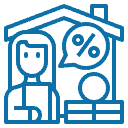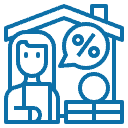Wealth Creation & Tax Obligations
For the bulk of Americans, the main source of their family’s overall net worth is derived from the equity in their primary home residence. Equity is defined as the difference between any mortgage debt and the current market value. As per Bloomberg and Zillow, an estimated 37% of all homes nationwide are owned free and clear with no mortgage debt.
Most property owners want to create equity wealth in their properties while reducing their debt and tax obligations as well. If so, this combination will likely increase their overall net worth.
While the risk of foreclosure by a lender has been eliminated after paying off the mortgage debt, any governing tax body {federal, state (not applicable in Washington), property taxes, or special assessment levies for new schools, roads, or other community upgrades} still holds superior interests in the property over and above the property owner. If you don’t pay your tax obligations, one or more tax agencies can place a lien on your property and later foreclose if not paid.
Capital Gains & 1031 Tax-Deferred Exchanges
A capital gains tax is a tax that investors pay on the profit of an asset like stocks or real estate. The amount of tax that you’re required to pay depends upon your income tax bracket, filing status, and length of time that you owned the asset.
It’s been said that time is the most precious commodity of them all. Time is also a key factor as it relates to tax agencies deciding how much of your profit that you will need to pay as a capital gains tax.
For investments held less than a year, the profit is considered to be a short-term gain and is taxed at a higher rate. Other investments held more than a year are considered as a long-term gain and are taxed at lower rates.
For 2021 and 2022, the seven ordinary income tax bracket rates that would apply towards investment properties held for a year or less are as follows:

The more money that you earn, the higher your tax bracket may be unless you have a lot of deductions and options to defer your profits well into the future like seen with a 1031-tax deferred exchange where taxable gains are delayed and transferred to future property investments.

As per the Internal Revenue Code (IRC) §1031 legal code that set the precedent for tax-deferred exchanges, an investor has up to 45 days from the date of sale of their relinquished property to identify one or more replacement properties. Then, the investor has up to 180 days to close escrow. If so, the investor does not pay any ordinary income or capital gains taxes at the time of closing. The gains are deferred well into the future.
(a) Non-Recognition of Gain or Loss From Exchange Solely in Kind.
(1) In general. “No gain or loss shall be recognized on the exchange of property held for productive use in a trade or business or for investment if such property is exchanged solely for property of like-kind which is to be held either for productive use in a trade or business or for investment.”
Source: 26 U.S. Code § 1031 – Exchange of real property held for productive use or investment

Now, let’s review the capital gains tax rate options that would apply for long-term gains on investments held more than 12 months:

As you can clearly see, your tax rates are much lower when you hold the property for more than one year. Please check with your tax advisors first before making any decision.

How Napkins Soak Up Tax Obligations
Learning about taxes can be quite intimidating and not very fun for many people. For those of us who aren’t accountants, how can we simplify the 1031 tax-deferred exchange rule for rental properties? The Napkin Test is our answer.
The Napkin Test literally was created on the back of a cocktail napkin in a bar by a California tax attorney named Marvin Starr. It was quite creative how he simplified the 1031 tax-deferred exchange process by writing these words with upward arrow symbols on his cocktail napkin as follows:

Under the 1031 tax code, the investor is required to exchange into one or more properties for so long as they increase the amount of equity (cash into the new property or properties), debt (mortgage), and value (combined purchase price amount).
Over the past year, the median asking price for a home in King County was $899,900 as of August 2022, which was a 20.1% year-over-year increase as per Realtor.com. Can you imagine deferring hundreds of thousands of dollars in property gains without paying taxes? Many of our clients have compounded their net worth gains by using our sales and management services while reducing their tax hits at the same time.
Our experienced staff and our financial and accounting affiliates can assist you by reducing the risk of the IRS taking a big bite out of your profits by way of the 1031 tax-deferred exchange and other strategies.
Email us today so that we can help you!
















